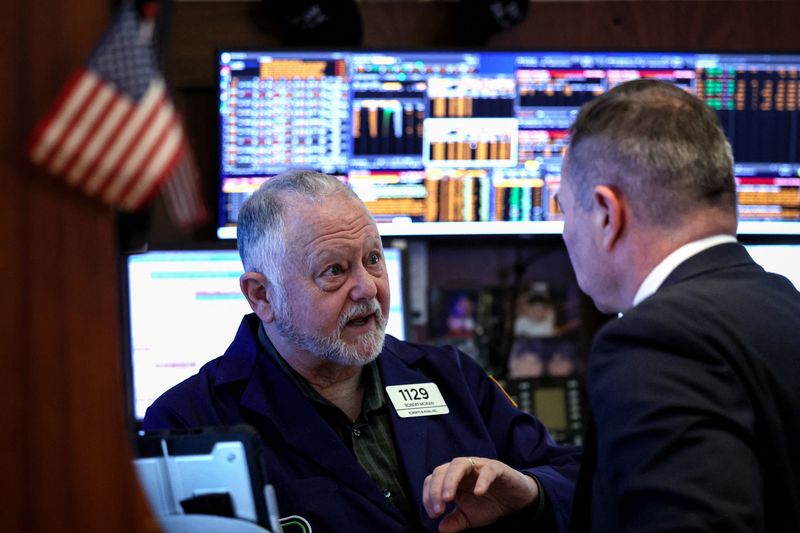By Sinéad Carew and Bansari Mayur Kamdar
(Reuters) - Wall Street's three major stock indexes on Thursday registered record closing highs for the second day in a row after the Federal Reserve reassured investors about the prospects for rate cuts this year while chip stocks rallied after Micron Technology (NASDAQ:MU)'s upbeat forecast.
The three major indexes had also hit fresh intra-day record highs earlier on Thursday and the Dow ended the day less than 1% away from the 40,000 for the first time.
Shares in Micron Technology finished up more than 14% after hitting an all-time high following a surprise quarterly profit and its forecast of third-quarter revenue above estimates.
Broadcom (NASDAQ:AVGO) shares ended up 5.6% after TD (TSX:TD) Cowen upgraded its rating of the stock to "outperform". Shares in Nvidia (NASDAQ:NVDA) were also a big boost as it added more than 1%while the Philadelphia Semiconductor index rallied 2.3%.
U.S. stock indexes had also boasted record closing levels on Wednesday after U.S. central bankers kept borrowing costs unchanged and indicated they still expect to ease interest rates by three-quarters of a percentage point by the end of 2024.
"Earnings results are keeping semiconductors as market leaders but more broadly a risk on mode has stemmed from the dovish Fed on Wednesday," said Matthew Miskin, Co-Chief Investment Strategist at John Hancock Investment Management.
Fed Chair Jerome Powell said told reporters after the Fed's policy meeting on Wednesday that inflation reports "haven't really changed the overall story, which is that of inflation moving down gradually on a sometimes bumpy road to 2%."
But John Hancock's Miskin questioned whether the Fed is being overly optimistic about inflation and rate cuts.
"They're opening to door to let inflation risk seep back into the market. It's not there yet but it's a risk that could come later this year," he said.
In the meantime, however, economic data released earlier on Thursday added to investors' bullish moods.
The number of Americans filing new claims for unemployment benefits unexpectedly fell last week, while sales of previously owned homes increased by the most in a year in February, signs the economy remained on solid footing in the first quarter.
"This economy continues to defy expectations and markets are loving every minute of it," said Miskin.
The Dow Jones Industrial Average rose 269.24 points, or 0.68% , to 39,781.37, the S&P 500 gained 16.91 points, or 0.32%, to 5,241.53 and the Nasdaq Composite gained 32.43 points, or 0.20%, to 16,401.84.
Nine of the 11 major S&P 500 industry sectors were higher, with industrials leading gains and finishing up 1%. The weakest sector was utilities, which ended down 0.2%, followed by a 0.17% drop in communications services, which saw its biggest drag from Alphabet (NASDAQ:GOOGL), down 0.8%.
Goldman Sachs (NYSE:GS) closed up 4.4%, leading gains in the Dow and in the rate sensitive bank sector. The S&P 500 bank sector added 1.7%.
Apple (NASDAQ:AAPL) bucked the market trend by closing down 4.1% after the U.S. Department of Justice sued the iPhone maker, the first major antitrust effort against the company by the Biden administration, alleging it monopolized smartphone markets.
Shares in IT services provider Accenture (NYSE:ACN) tumbled 9% after it cut its fiscal-year 2024 revenue forecast, with economic uncertainty prompting its clients to cut consulting services spending.
Reddit shares closed at $50.44 after it started trading on the New York Stock Exchange for the first time with at $47, which was 38% above its $34 initial public offer price.
Advancing issues outnumbered decliners by a 2.34-to-1 ratio on the NYSE which showed 918 new highs and 56 new lows.
On the Nasdaq Composite, 1,776 stocks rose and 1,400 fell as advancing issues outnumbered decliners by a 1.27-to-1 ratio.
The S&P 500 posted 116 new 52-week highs and one new low while the Nasdaq recorded 365 new highs and 59 new lows.

On U.S. exchanges 11.43 billion shares changed hands compared with the 12.39 billion moving average for the last 20 sessions.
(This story has been corrected to say that nine sectors rose, not 10, and that utilities was the weakest sector, not communications services, in paragraph 14)